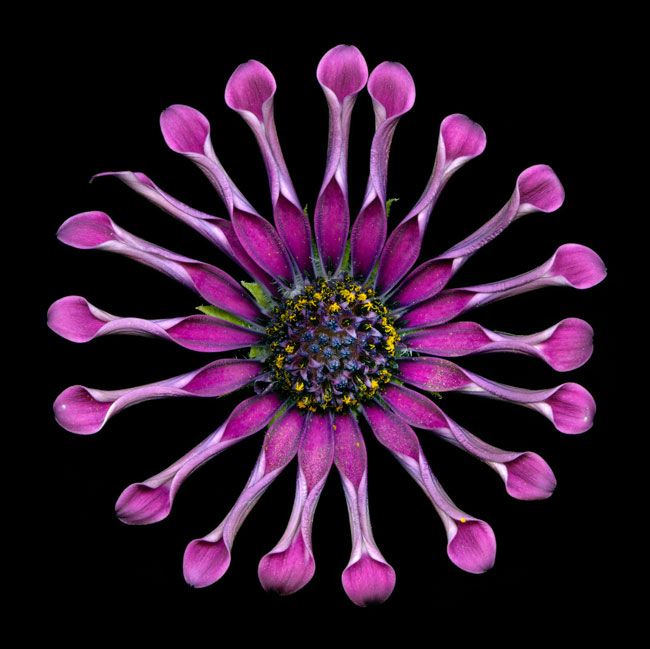Techniques: Flower Power
Focus Stacking for Close-Up Depth and Detail
Not to scare you off right at the start, but David Leaser, who is super enthusiastic about the close-up focus stacking technique he used to make these photographs, told us that if he walks away from it for a week or so he has to sort of relearn it. There are, he says, a lot of steps.
But the payoff is worth it, as focus stacking solves the issue of limited depth of field when shooting macro photographs.
David was inspired to try the technique when he returned from the Amazon where he’d been shooting landscapes before turning his attention to “the little ecosystems on the floor of the rainforest.” The problem was capturing all the detail and structure he was seeing in the plants and flowers. “The depth of field wasn’t great enough at any f/stop to get all that I wanted in an image,” he says. He returned home, did some research and pretty soon he’d worked out the general method and gathered the gear he needed: a D3X, an AF-S Micro NIKKOR 60mm f/2.8G ED, the R1C1 wireless close-up Speedlight system, a Cognisys StackShot, a super-sturdy tripod and Zerene Stacker software.
The StackShot is a motorized rail device that sits atop the tripod and moves the D3X and its manually focused 60mm Micro NIKKOR toward the close-up subject at chosen, preset intervals; David favors .3mm because he’s found it works best within the depth-of-field range of the 60mm lens. The D3X, tethered to his laptop, takes a single image at each interval, and with the camera set for Live View, David sees on the laptop’s screen exactly what the lens sees and the camera captures.
He does not change the focus of the lens, as he’s determined that along the length of the StackShot’s travel he will get enough sharp elements in the frames for the software to combine into the final image. David typically takes several dozen shots as the StackShot moves closer and closer to the flower; the software will automatically choose the sharpest parts of each image and combine them into one.
Fortnight Lily -
Not to scare you off right at the start, but David Leaser, who is super enthusiastic about the close-up focus stacking technique he used to make these photographs, told us that if he walks away from it for a week or so he has to sort of relearn it. There are, he says, a lot of steps.
The R1C1 Speedlight fires for each frame. “I set the flash for auto operation and take some test shots before I start,” David says. “I see the results on the laptop and can tell if any adjustments to position or output are needed.” David places Sto-Fen Omni-Bounce flash diffusers on each of the R1C1’s flash heads to soften the light. When the lens comes within three inches of the subject, he’ll add the close-up diffusers that come with the R1C1 kit.
He will sometimes use an SB-900 to illuminate areas that may not be covered by the close-up flash. “The close-up system is very focused on the flower,” David says, “but I may need to add more light to a stem, so I’ll use an SB-900 with the diffuser that comes with it or with a LumiQuest softbox, and I’ll fire the SB-900 with the SU-800 wireless commander unit in the camera’s hot shoe.”
David shoots the images as NEF files, then batch processes them to TIFF files in Photoshop and makes any color or exposure adjustments he feels are necessary. He’ll then take the images into Zerene Stacker, and the software will make its selection and combination of sharp sections. The results show remarkable depth, clarity and detail, and David has made 44x60 canvas prints of images for exhibit and fine art sale.
A last but not least essential: flowers worthy of the effort and capable of eliciting a “Wow!” response. David buys his at the Los Angeles flower mart or grows them himself. We can tell you that while information about all the hardware and software mentioned here, as well as details, guidelines and tutorials about the focus stacking technique, can be found online by Googling keywords, names and phrases, you’re totally on your own when it comes to flower choice.
Fuchsia -
Close Taker -
David readies his focus stacking setup for close-up photography. The flower photos here were taken with the D3X, AF-S Micro NIKKOR 60mm f/2.8G ED and R1C1 wireless close-up Speedlight system you see on the Cognisys StackShot, which is mounted on a Manfrotto 3251 tripod. The camera's settings were consistent for all the images: 1/60 second, f/16, ISO 100, manual exposure and Matrix metering. For the image he's making in this photo, he added an SB-900 to shed some light on the flower's stem.
Additional important parts of the setup are the little blue Wimberley Plamp, vital for gently holding the flower still, and, at left, the clamp-on halogen desk lamp that David uses to give him lots of light to manually focus the lens, then turns off when the shooting starts.












